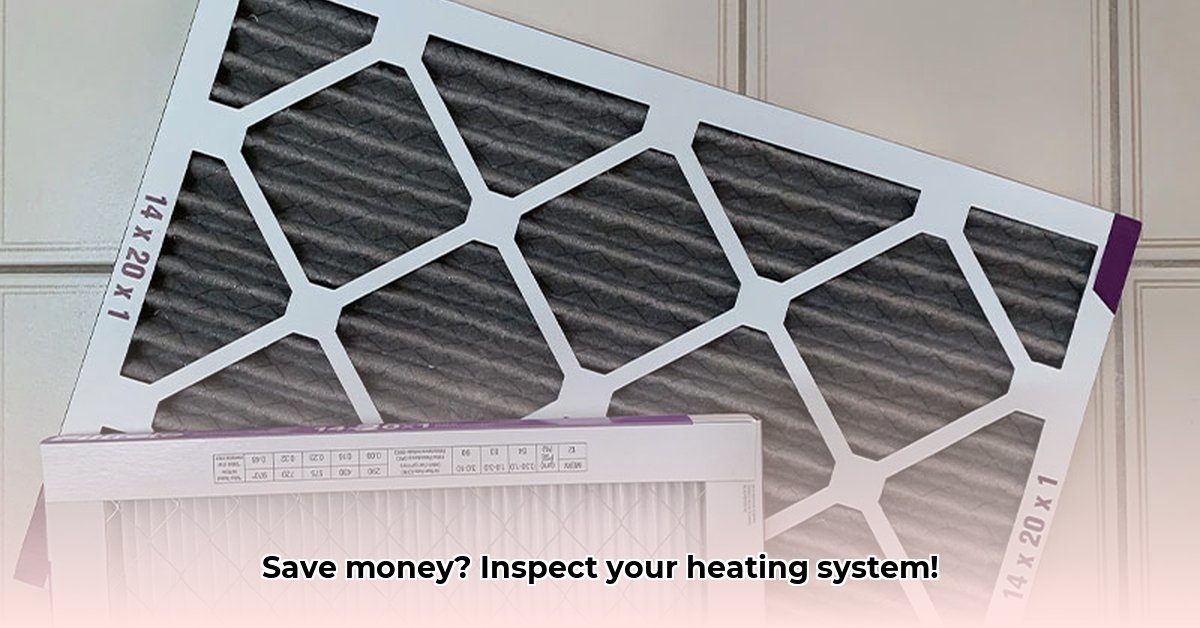Freezing temperatures and a broken heater are a nightmare scenario. Preventative maintenance is key to avoiding hefty repair bills and a chilly winter. This guide covers everything you need to know about heating system inspections: what to expect, what to look for, and how to ensure your system is ready for winter. We’ll cover visual inspections, understanding limitations, and what to do if you find a problem. For more in-depth information on HVAC systems, check out this helpful resource: HVAC maintenance guide.
Heating System Inspections: Protecting Your Home’s Heart with Preventative Maintenance
Nobody wants their heating system to fail during a blizzard. Regular heating system inspections are crucial for preventing costly repairs and ensuring warmth. Think of it as a yearly check-up for your car – preventative maintenance saves money and keeps you comfortable. This guide will walk you through what to expect during an inspection and how to work with your inspector to maintain your home’s heating system. It’s not simply about fixing what’s broken; it’s about proactively ensuring system efficiency and preventing future issues.
What to Expect During Your Heating System Check-Up: HVAC System Evaluation
A thorough heating system inspection evaluates key parts. Here’s a breakdown of common components and potential issues:
- Furnace Inspection (If Applicable): The inspector will examine the burners for an even, blue flame; uneven or yellow burning indicates problems. Rust or corrosion is a red flag. They’ll check the blower motor and belts for wear, listening for unusual noises like squealing or grinding. Critically, they’ll inspect the heat exchanger for cracks, a serious safety hazard that can leak carbon monoxide.
- Boiler Inspection (If Applicable): The inspector will check for leaks around pipes and fittings, as even small leaks can indicate larger problems like failing seals or corrosion. They’ll check the pressure gauge to ensure it’s within the safe operating range (typically 12-15 PSI for residential systems) and the water level in the sight glass. They’ll listen for gurgling sounds, indicating air in the system, which can reduce efficiency. Corrosion is a major concern, leading to expensive repairs. Ensuring optimal boiler performance not only saves money on energy bills but also extends the lifespan of the system.
- Heat Pump Inspection: The focus shifts to refrigerant lines; the inspector will look for leaks, as these reduce efficiency and require costly repairs. The outdoor unit will be inspected for debris buildup, such as leaves, grass clippings, or snow, which restricts airflow and reduces performance. The fan’s operation will be checked; it should run smoothly and quietly. The inspector should also check the defrost cycle to ensure it’s functioning correctly.
- Vents and Ductwork: The inspector will check if vents are clear and unobstructed. Blocked vents restrict airflow, lowering efficiency and potentially causing the system to overheat. They’ll also look for cracks or damage in visible ductwork, which can lead to air leaks and energy loss. Pay close attention to ductwork in unconditioned spaces like attics and crawlspaces. Sealing and insulating ductwork properly can improve system performance by as much as 20%, thus helping control energy costs and maximize comfort.
- Thermostat: The Brain of the Operation: The inspector will check if it’s responding correctly and accurately reflecting the temperature. A faulty thermostat can lead to inconsistent heating and energy waste. They should also verify that the thermostat is properly calibrated and programmed. Smart thermostats offer energy-saving features and remote control.
Understanding Inspection Limitations: Identifying HVAC Vulnerabilities
While a visual inspection is useful, it has limitations. Some problems are invisible to the naked eye. Subtle cracks within a heat exchanger or minor refrigerant leaks might not be detectable without specialized equipment like combustion analyzers or refrigerant leak detectors. Therefore, your inspector might recommend further testing, such as a pressure test or in-depth analysis by an HVAC professional. Also, inspectors typically don’t assess the internal components of sealed units like compressors.
Talking to Your Heating System Inspector: Understanding the Inspection Process
Ask questions! Your inspector should welcome your curiosity and explain findings in clear language. After the inspection, review the report carefully. If anything is unclear, contact the inspector or a qualified HVAC technician. Effective communication ensures you understand the condition of your heating system and how to maintain it. Ask for clarification on technical terms and potential solutions.
Your Action Plan for a Healthy Heating System: Regular HVAC Checkups
Follow these steps to maintain your heating system:
- Schedule annual inspections: Preventative maintenance is cheaper than emergency repairs. Plan inspections before peak heating season.
- Ask targeted questions: Before the inspection, write down any specific concerns, such as unusual noises or inconsistent heating.
- Budget for repairs: Set aside money for unexpected repairs. A home warranty can provide financial protection.
- Keep detailed records: Maintain a file of inspection reports and repair records. This helps track system performance and identify recurring issues.
Advanced Topics: Delving Deeper into HVAC Systems
Different heating systems have unique needs. Older systems might use R-22 refrigerant, being phased out due to environmental concerns; replacing these systems with newer, more efficient models can be a worthwhile investment. Specialized tools like thermal imaging cameras can reveal hidden problems, such as insulation gaps or overheating components, but require technicians with specific expertise. Combustion analysis measures the efficiency of fuel-burning systems and identifies potential safety hazards.
Potential Heating System Problems: A Quick Reference Guide
| Component | Potential Problems | Severity | Recommended Action |
|---|---|---|---|
| Furnace Burner | Uneven flame, rust, corrosion, noisy operation | Medium-High | Repair or replacement of affected components |
| Heat Exchanger | Cracks, leaks, rust | High | Immediate professional attention; potential safety hazard |
| Boiler Pipes | Leaks, corrosion, low water pressure | High | Immediate repair; potential water damage |
| Heat Pump Refrigerant | Leaks, low refrigerant levels | Medium-High | Repair or recharge refrigerant; address leak source |
| Ductwork | Blockages, leaks, cracks, improper insulation | Medium | Professional cleaning and repair of ductwork |
| Thermostat | Inaccurate readings, failure to respond correctly | Low-Medium | Replacement of thermostat |
| Blower Motor | Unusual noises, poor airflow, overheating | Medium | Repair or replacement of the blower motor |
| Chimney/Flue | Blockage, corrosion, improper draft | High | Professional inspection and cleaning; potential fire hazard |
| Condensate Drain | Clogs, leaks | Low-Medium | Clear clogs, repair leaks to prevent water damage |
Regular heating system inspections are a vital part of home maintenance, protecting your home from costly repairs and ensuring your family’s comfort. Don’t wait until it’s too late!
How to Choose a Home Inspector Specializing in Aging HVAC Systems: Evaluating HVAC Expertise
Older homes have unique heating system challenges, from outdated technology to degraded components. A thorough inspection identifies potential problems before they become costly emergencies. Choosing the right home inspector is crucial for accurate assessment, and understanding inspection limitations helps manage expectations. Proactive maintenance prevents future breakdowns and saves money. It involves not only understanding the system’s age but also being equipped to handle specific issues prevalent in older models.
What to Look For in an Aging HVAC System Inspection: Identifying Vulnerabilities
An aging HVAC system needs special attention. Don’t just look for obvious problems; a skilled inspector will delve deeper. Here’s what you should expect:
- Furnace: The inspector will check for rust, cracks in the heat exchanger, and proper ventilation. They should also assess the burner and ignition system, looking for signs of inefficiency or malfunction. Pay close attention to the condition of the flue pipe.
- Boiler: Look for signs of corrosion, leaks, and proper water pressure. They’ll check the pressure relief valve and examine the system’s efficiency. Scale buildup in older boilers is a common issue that reduces efficiency.
- Heat Pump: Inspectors will check refrigerant levels, compressor operation, and the unit’s overall condition. They should also inspect the reversing valve, which controls the heating and cooling modes.
- Vents and Ductwork: The inspector looks for leaks and ensures proper airflow. Asbestos insulation in older ductwork is a potential hazard.
- Thermostat: Check if it responds accurately to temperature adjustments. Outdated thermostats may not be compatible with modern energy-saving features.
Understanding Inspection Limitations: Recognizing the Scope of the Assessment
A standard home inspection isn’t a complete mechanical analysis. While a good inspector will spot visible problems, some issues require specialized equipment, or internal component failures may not be apparent initially.
Don’t expect a home inspector to:
- Diagnose complex electrical faults within the system.
- Perform a full-scale efficiency test requiring specialized equipment.
- Conduct destructive testing, which could damage the system.
- Disassemble sealed components for internal inspection.
They will, however, recommend a follow-up inspection by a qualified HVAC technician if they suspect serious problems.
Communicating Effectively with Your Inspector: Clarifying the Inspection Process
Effective communication is key. Before the inspection, clarify your concerns and ask targeted questions. Afterward, review the report carefully and follow up on any unanswered questions or unclear points.
Ask these questions when choosing your inspector:
- Do you
- Unlock Your Future: Community Colleges in Florida with Childhood Education Programs – Your Affordable Path - September 14, 2025
- Unlock Futures: Catawba College Growth Strategy Insights 2025 - September 14, 2025
- Your Complete Guide to Eastfield Community College | 2025 Programs & Insights - September 14, 2025



![Fast Track Your Legal Career: Broome Community College Paralegal Studies AAS [2025 Guide] broome_community_college_paralegal_studies_edited](https://baufinanzierung-ausland.de/wp-content/uploads/2025/08/broome_community_college_paralegal_studies_edited-150x150.jpg)











